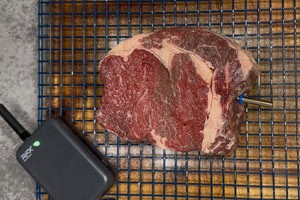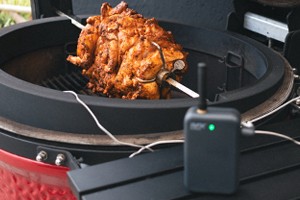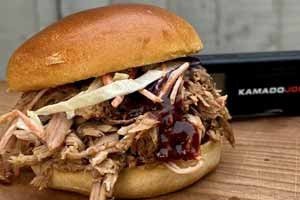Easy, tender BBQ pulled pork, loaded into buns with coleslaw and BBQ sauce.
Wine Serving Temperatures — Red, White, Sparkling
Perfect pairing starts with perfect temperatures.
Serving wines at their optimal temperature is key to unlocking their best flavours. Too warm? You’ll lose the freshness. Too cold? Say goodbye to those delicious aromas.
Get it just right, and you’ll elevate your tasting experience to gourmet status.
What Temperature Should Red Wine Be Served At?
You should serve wine between 14 °C and 19 °C, depending on the type. Light reds are best served at cooler temperatures, while full-bodied reds taste best served slightly warmer.
Room temperature typically falls between 18 °C and 22 °C. So if you don't have a wine fridge or cellar, you may want to chill your red wine in the fridge briefly before serving.
Decanting red wine before serving releases aromas, helping the flavours to develop.
Red wine serving temperatures:
Vintage port: 19 °C
Bordeaux, shiraz: 18 °C
Cabernet sauvignon: 17 °C
Pinot noir: 16 °C
Chianti, zinfandel: 15 °C
Tawny port, madeira : 14 °C

What Temp to Serve White Wine?
Rosé and white wine serving temperatures fall between 6 °C and 12 °C, depending on the type. Lighter, fresher white wines are best served at a cooler temperature, while full bodied white wines can be served slightly warmer.
Fridges containing food should be kept at 5 °C, so unless you have a dedicated wine fridge, you should remove your white wine from the fridge a little early before serving.
Always avoid serving your wine above 20 °C, however. At this temperature the flavours start to spoil.
It's better to serve wine a little too cold than too warm. You can always warm the glass up in your hands.
White wine serving temperatures:
Beaujolais rosé: 12 °C
Sauternes: 11 °C
Chardonnay: 10 °C
Pinot grigio, sauvignon blanc, riesling: 9 °C
Ice wines: 6 °C
What Temperature to Serve Sparking Wines?
Sparkling wines such as champagne and prosecco should be served at 7 °C. This gets the fizz and aromas just right.
How to Measure Wine Temperature?
We recommend using an instant-read kitchen thermometer, such a Thermapen. You can use this to probe an open bottle, or stir through a glass. Then you'll know whether your wine will benefit from a quick chill in the fridge or resting a little before serving.
The Takeaway
The best red wine temperatures for drinking are between 14 °C and 19 °C. White wines should be served between 6 °C and 12 °C. Sparkling wines should be served at 7 °C.
As a rule of thumb, lighter wines can be served at cooler temperatures, while full bodied wines are best served slightly warmer.
Never serve wine over 20 °C.
Test your wine temperature using an instant-read thermometer like a Thermapen. Use this to guide whether your wine needs some time in the fridge or resting before serving.
The best red wine temperatures for drinking are between 14 and 19 °C. White wines should be served between 6 °C and 12 °C. Sparkling wines should be served at 7 °C.
Related posts
 5 Best Cooking Christmas Gifts 2025
5 Best Cooking Christmas Gifts 2025
 How To Make & Serve Mulled Wine
How To Make & Serve Mulled Wine
 How Long to Rest a Turkey
How Long to Rest a Turkey
 The Ultimate Turkey Cooking Guide
The Ultimate Turkey Cooking Guide
 Mike Tomkins’ Hunter’s Chicken
Mike Tomkins’ Hunter’s Chicken
Search
Categories
- Baking (35)
- BBQ (85)
- Autumn (14)
- Cheap Eats (9)
- Sweet Treats (38)
- Tips, Advice & Info (78)
- Christmas (36)
- Drinks (2)
- Thermapen Father's Day Recipes (18)
- Team Temperature (28)
- Date Night (37)
- Celebrations (20)
- Family & Kids (10)
- Fish (21)
- Low & Slow (13)
- Meat (142) click
-
Chefs (132)
click
- Kenny Tutt (16)
- Richard Holden (16)
- Barbechoo (7)
- Only Slaggin (1)
- SoSaSe Chocolat (1)
- Genevieve Taylor (5)
- Becky Excell (2)
- Charlotte Stirling-Reed (3)
- The Smokin Elk (13)
- Marcus Bawdon (2)
- Thermapen Chef (25)
- Edd Kimber (2)
- Humble Plates (7)
- Simon May (4)
- The Hedgecombers (3)
- Billy & Jack (4)
- Perfectly Preserved (3)
- Mike Tomkins (20)
- DJ BBQ (2)
- Nick Nairn (4)
- BBQ Jake (1)
- Air Fryer (9)
- RFX (6)
- Featured (3)
Latest recipes

Rotisserie-cooked chicken shawarma, coated in a punchy yoghurt marinade. Pile into flatbreads with salad

Ribeye is an amazing, flavour-packed cut of beef. Learn how to cook ribeye steak medium rare using the reverse sear...

Elky Whittaker, aka The Smokin’ Elk, began barbecuing as a hobby 10 years ago. Today, he has 262k Instagram followers...

Juicy BBQ chicken shawarma recipe with homemade flatbreads and garlic sauce.
Archive
Popular Recipes








